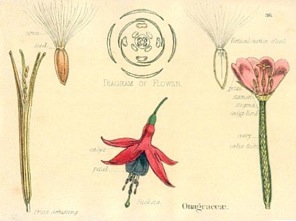
The Genus Fuchsia
Fuchsia triphylla, flore coccineo...

Father Charles Plumier (1646-1704) was the Minim monk and French royal botanist to Louis XIV who is generally credited with the discovery of the first fuchsia. His notes and drawings of the genus, observed with many other firsts on his third trip to the island of Hispaniola in 1695/96, were published in Nova Plantarum Americanarum Genera in Paris in 1703. Plumier baptized the novel species Fuchsia triphylla, flore coccineo… in honor of Leonhart Fuchs (1501-1566). While Fuchs never met his Fuchsia, he was an eminent physician and botanist who had occupied the chair of medicine at the University of Tübingen in Germany and authored the celebrated De Historia Stirpium in 1542. The eminent Doctor Fuchs is now considered one of the three fathers of modern botany and Plumier chose wisely in signaling him out for the honor. Linnaeus later shortened the unwieldy descriptive name common in Plumier's time to accord with his own new binomial system of classification.
Today, 108 species representing 122 taxa of the genus Fuchsia are scientifically recognized and organized into twelve sections based on shared characteristics. Most species in this genus are found in Central and South America. Additionally, two species occur on the island of Hispaniola, three in New Zealand and one in the highlands of Tahiti.
Taxonomists often rethink and rearrange. Sometimes scientific names are rendered obsolete in the process, and even long-standing species seemingly disappear. In a new treatment, for example, a botanist might determine that an herbarium specimen had been misidentified as a new species but had already been validly described under another name by an earlier scientist. According to the rules of nomenclature, the earlier name wins out and the later one becomes a botanical synonym, that's to say, it becomes totally invalid.
This invalidation has happened within Fuchsia a number of times. Names which you might still come across in older references or publications, such as Fuchsia jahnii, F. osgoodii or F. munzii, aren't current and aren't listed below. The species listed here are those which are published and accepted as valid by Dr. Paul E. Berry, the world's leading authority on the Genus Fuchsia, and a handful of other authors working on the genus. (➤ Scientific Bibliography)
Don't see that favorite species you've been cultivating for years, though? Don't despair. Known synonyms are listed at the end of the various species entries. You can also check the missing name directly in the ➤ Dictionary of the Fuchsia. That will point you in the right direction. The Dictionary will also provide further insight into the who's and why's. And there are sometimes colorful and intriguing tales involved, as well!
➤ World Flora Online (which replaced the previous The Plant List) is a cooperative endeavor by several leading botanical institutions to maintain an on-line working list of all plant species, also contains most currently accepted Fuchsia species names as well as invalid synonyms. However, despite its attempts to be universally accurate, the Plant List does still contain a slight number of inaccuracies lurking within its immense database of listings.
Finally, if you find you’re developing a special itch and more than a casual interest in species fuchsias, consider joining the Western Fuchsia Species Society in the United States. Or perhaps the species section of your own national society. If there isn't such a section, start one! Species have an appeal all their own. Even though a few might have special preferences to challenge the experienced gardener, most take well to cultivation and are quite easy to grow.
Fuchsia triphylla, flore coccineo...

Father Charles Plumier (1646-1704) was the Minim monk and French royal botanist to Louis XIV who is generally credited with the discovery of the first fuchsia. His notes and drawings of the genus, observed with many other firsts on his third trip to the island of Hispaniola in 1695/96, were published in Nova Plantarum Americanarum Genera in Paris in 1703. Plumier baptized the novel species Fuchsia triphylla, flore coccineo… in honor of Leonhart Fuchs (1501-1566). While Fuchs never met his Fuchsia, he was an eminent physician and botanist who had occupied the chair of medicine at the University of Tübingen in Germany and authored the celebrated De Historia Stirpium in 1542. The eminent Doctor Fuchs is now considered one of the three fathers of modern botany and Plumier chose wisely in signaling him out for the honor. Linnaeus later shortened the unwieldy descriptive name common in Plumier's time to accord with his own new binomial system of classification.

Today, 108 species representing 122 taxa of the genus Fuchsia are scientifically recognized and organized into twelve sections based on shared characteristics. Most species in this genus are found in Central and South America. Additionally, two species occur on the island of Hispaniola, three in New Zealand and one in the highlands of Tahiti.
Taxonomists often rethink and rearrange. Sometimes scientific names are rendered obsolete in the process, and even long-standing species seemingly disappear. In a new treatment, for example, a botanist might determine that an herbarium specimen had been misidentified as a new species but had already been validly described under another name by an earlier scientist. According to the rules of nomenclature, the earlier name wins out and the later one becomes a botanical synonym, that's to say, it becomes totally invalid.
This invalidation has happened within Fuchsia a number of times. Names which you might still come across in older references or publications, such as Fuchsia jahnii, F. osgoodii or F. munzii, aren't current and aren't listed below. The species listed here are those which are published and accepted as valid by Dr. Paul E. Berry, the world's leading authority on the Genus Fuchsia, and a handful of other authors working on the genus. (➤ Scientific Bibliography)
Don't see that favorite species you've been cultivating for years, though? Don't despair. Known synonyms are listed at the end of the various species entries. You can also check the missing name directly in the ➤ Dictionary of the Fuchsia. That will point you in the right direction. The Dictionary will also provide further insight into the who's and why's. And there are sometimes colorful and intriguing tales involved, as well!
➤ World Flora Online (which replaced the previous The Plant List) is a cooperative endeavor by several leading botanical institutions to maintain an on-line working list of all plant species, also contains most currently accepted Fuchsia species names as well as invalid synonyms. However, despite its attempts to be universally accurate, the Plant List does still contain a slight number of inaccuracies lurking within its immense database of listings.
Finally, if you find you’re developing a special itch and more than a casual interest in species fuchsias, consider joining the Western Fuchsia Species Society in the United States. Or perhaps the species section of your own national society. If there isn't such a section, start one! Species have an appeal all their own. Even though a few might have special preferences to challenge the experienced gardener, most take well to cultivation and are quite easy to grow.
-
Genus & Family
Open or CloseFuchsia is a genus of shrubby, flowering plants in the Onagraceae, the Evening Primrose family, of the order Myrtales. The 108 species representing 122 taxa are grouped into 12 sections. The generally simple lanceolate leaves are usually serrated and opposite or held in whorls of three to five.
The pendulous flowers are decorative and profusely borne during the summer, or even all year. This has led to their early introduction and widespread use, especially as interspecific hybrids, in gardens. Generally, the flowers consist of four sepals over four shorter, broader petals at the end of a tube of varying length.
In the nine species of the Quelusia Section the sepals are bright red over petals of bright purple-blue. Other species appear more uniformly colored and range through shades of red and orange often with flourishes of paler color, yellow or some green on the petals and ends of the sepals. The flowers are a particular favorite of hummingbirds, but are also frequently visited by bees and butterflies.
The fruit is a small epiygnous berry, usually of a very dark color ranging from deep burgundy to deep purple-black when ripe, and contains many tiny seeds. It's edible. The pleasant taste is variously described as slightly grapey or even peppery and can range from mildly sub-acid to sweet depending on the species.
Fuchsia is a member of the Onagraceae, the Evening Primrose or Willowherb family. Besides Fuchsia, it includes a number of other popular garden plants, such as evening primroses (Oenothera), white gaura (Gaura lindheimeri), or mountain garland (Clarkia unguiculata). The widely distributed fireweed or rosebay willow herb (Epilobium angustifolium) is also a common weed in gardens.
This cosmopolitan and widely distributed plant family, of which Oenothera is the type species, contains approximately 640 to 650 species of herbs, shrubs, and trees divided into approximately twenty-three or twenty-four genera. The family is divided into two subfamilies, the Ludwigioidiae, which contains the single species Ludwigia, and the Onagroideae, further divided into six tribes. Along with it's most closely related cousin genus, Circaea, Fuchsia is nestled within the Circaeeae tribe ( sometimes also called the Fuchsieae tribe) within the Onagroidiae subfamily.
Onagraceae species are found on every continent (expect Antarctica) and range from boreal to tropical regions (except the arid regions of Australia and Africa).
They are characterized by flowers usually with four sepals and four petals, generally pollinated by bees but also by hummingbirds and butterflies.
The seeds of Onagraceae members are very small. In some genera, such as Epilobium, they have a tuft of down and are dispersed by the wind. In others, such as Fuchsia, the seeds are contained in a berry and are dispersed by birds.
Onagraceae leaves are most commonly opposite or whorled, spirally arranged in some species, and are generally simple and lanceolate in shape.Onagraceae & Its Genera
Subfamily Ludwigioideae
Ludwigia L.
Subfamily Onagroideae
Tribe Circaeeae
Circaea L.
Fuchsia L.
Tribe Epilobieae
Chamerion Raf. ex Holub
Epilobium L.
Tribe Gongylocarpeae
Gongylocarpus Schltdl. & Cham.
Tribe Hauyeae
Hauya DC.
Tribe Lopezieae
Lopezia Cav.
Megacorax Elizondo et al
Tribe Onagreae
Camissonia Link
Camissoniopsis
W.L.Wagner & Hoch
Chylismia (Torr. & A.Gray) Raim.
Chylismiella (Munz) W.L.Wagner & Hoch
Clarkia Pursh
Eremothera (P.H.Raven) W.L.Wagner & Hoch
Eucharidium Fisch. & C.A.Mey.
Eulobus Nutt. ex Torr. & A.Gray
Gayophytum A.Juss.
Neoholmgrenia W.L.Wagner & Hoch
Oenothera L.
Taraxia (Torr. & A.Gray) Raim.
Tetrapteron (Munz) W.L. Wagner & Hoch
Xylonagra Donn.Sm. & RoseThe Tree of Life
Genus—Fuchsia
Tribe—Fuchsieae / Circaeeae
Subfamily—Onagroideae
Family—Onagraceae
Suborder—Onagrineae
Order—Myrtales
Superorder—Mytanae
Subclass—Rosdiae
Class—Magnoliopsida
Infraphylum—Radiatopses
Subphylum—Euphyllophytina
Phylum—Magnoliophyta
Subkingdom—Viridaeplantae
Kingdom: Plantae
Domain—Eucaryota
Life—Everything's related
so please take care of the Earth! -
Fuchsia Species by Section
Open or Close➤ Ellobium (3)- F. decidua
- F. fulgens
- F. splendens
➤ Encliandra (6)- F. encliandra (3)
- F. encliandra subsp. encliandra
- F. encliandra subsp. microphylloides
- F. encliandra subsp. tetradactyla
- F. microphylla (6)
- F. microphylla subsp. apica
- F. microphylla subsp. chiapensis
- F. microphylla subsp. hemsleyana
- F. microphylla subsp. hidalgensis
- F. microphylla subsp. microphylla
- F. microphylla subsp. quercetorum
- F. obconica
- F, parviflora (syn. F. cylindracea)
- F. ravenii
- F. thymifolia (2)
- F. thymifolia subsp. minimiflora
- F. thymifolia subsp. thymifolia
- F. x bacillaris
➤ Fuchsia (64)- F. abrupta
- F. ampliata
- F. andrei
- F. aquaviridis
- F. austromontana
- F. ayavacensis
- F. boliviana
- F. campii.
- F. canescens
- F. caucana
- F. ceracea
- F. cinerea
- F. cochabambana
- F. confertifolia
- F. coriaceifolia
- F. corollata
- F. corymbiflora
- F. crassistipula.
- F. cuatrecasasii
- F. decussata
- F. denticulata
- F. dependens
- F. ferreyrae
- F. fontinalis
- F. furfuracea
- F. gehrigeri
- F. glaberrima
- F. harlingii
- F. hartwegii
- F. hirtella
- F. hypoleuca
- F. lehmannii
- F. llewelynii
- F. loxensis
- F. macrophylla
- F. macropetala
- F. macrostigma
- F. magdalenae
- F. mathewsii
- F. nigricans
- F. orientalis
- F. ovalis
- F. pallescens
- F. petiolaris
- F. pilosa
- F. polyantha.
- F. pringsheimii
- F. putumayensis
- F. rivularis (2)
- F. rivularis subsp. rivularis
- F. rivularis subsp. pubescens
- F. sanctae-rosae
- F. sanmartina
- F. scabriuscula.
- F. scherffiana
- F. sessilifolia
- F. simplicicaulis
- F. steyermarkii
- F. summa
- F. sylvatica
- F. tincta
- F. triphylla
- F. vargasiana
- F. venusta
- F. vulcanica
- F. wurdackii
➤ Hemsleyella (15)- F. apetala
- F. cestroides
- F. chloroloba
- F. garleppiana
- F. huanucoensis
- F. inflata
- F. insignis
- F. juntasensis
- F. membranacea
- F. mezae
- F. nana
- F. pilaloensis
- F. salicifolia
- F. tillettiana
- F. tunariensis
➤ Jimenezia (1)- F. jimenezii
➤ Kierschlegeria (1)- F. lycioides
➤ Pachyrrhiza (1)- F. pachyrrhiza
➤ Procumbentes (1)- F. procumbens
➤ Quelusia (9)- F. alpestris
- F. bracelinae
- F. brevilobis
- F. campos-portoi
- F. coccinea
- F. glazioviana
- F. hatschbachii
- F. magellanica
- F. regia (3)
- F. regia subsp. regia
- F. regia subsp. reitzii
- F. regia subsp. serrae
➤ Schufia (2)- F. arborescens
- F. paniculata (2)
- F. paniculata subsp. paniculata
- F. paniculata subsp. mixensis
➤ Skinnera (3)- F. cyrtandroides
- F. excorticata
- F. perscandens
- F. x colensoi
➤ Verrucosa (1)- F. verrucosa
-
Key to Herbarium Specimens
Open or CloseNot all institutions have had their collections digitally photographed and made available for public study on-line, but a number do now have virtual herbaria. Links to individual specimens, where publicly available, are at the end of each species entry. For practical purposes, the species listings use these longer names over their traditional abbreviations in botany: It's simply easier to click on the words. Traditional herbarium abbreviations are in parentheses, however. The new ➤ JStor Global Plants is described as a "database where worldwide herbaria can share their plant type specimens". Unfortunately JStor images are only visible as small thumbnails to the general public and not available full-sized unless accessed through a participating institution with an annual subscription.
➤ Aarhus—University of Aarhus, Aarhus, Denmark (AAU)
➤ Arizona—University of Arizona, Tucson, Arizona (ARIZ)
➤ Arizona State—Arizona State University, Phoenix, Arizona (ASU)
➤ Austral Americano—Herbario Virtual Austral Americano (HVAA)
➤ Berlin—Botanischer Garten und Botanisches Museum Berlin-Dahlem, Berlin, Germany (B)
➤ Bishop—Bishop Museum, Herbarium Pacificum, Honolulu, Hawaii (BISH). JStor.
➤ California Academy—California Academy of Sciences, San Francisco, California (CAS/DS)
➤ Edinburgh—Royal Botanic Garden Edinburgh, Scotland (E)
➤ Field—Field Museum of Natural History, Chicago, Illinois (F)
➤ Kew—Royal Botanical Gardens Kew, London, United Kingdom (K)
➤ Missouri—Missouri Botanical Garden, St. Louis, Missouri (MO)
➤ New York—New York Botanical Garden, The Bronx, New York (NY)
➤ Paris—Muséum National d'Histoire Naturelle, Paris, France (P, PC)
➤ Smithsonian—United States National Herbarium, Smithsonian Institution, Washington DC (US)
➤ Texas—University of Texas, Austin, Texas (TEX) -
Dictionary of the Fuchsia
Open or Close -
Scientific Bibliography
Open or Close -
Species Collections
Open or Close➤ Arboretum de Versailles-Chèvreloup (FR)
The Arboretum is in the process of building a new greenhouse and garden for the display of fuchsias to the public. They will open in the Autumn of 2025.➤ Jack & Joan Lamb National Collection (UK)
A private national collection of fuchsia species. Conservation and research.➤ Lake Wilderness Arboretum (US)
A collection of species in the Quelusia Section, with some Encliandras, hardy in the Pacific Northwest. Hardy cultivars. -
Specialist Species Groups
Open or Close● SORAF - Société pour la Recherche et l'Acclimatation des espèces botaniques du genre Fuchsia (FR) -
Synonyms of Fuchsia
Open or CloseHeterotypic Synonyms (RGB Kew)- Brebissonia Spach in Ann. Sci. Nat., Bot., sér. 2, 4: 175 (1835)
- Dorvalia Hoffmanns. in Verz. Pfl.-Kult. 1833: 21 (1833)
- Ellobium Lilja in Linnaea 15: 262 (1841)
- Encliandra Zucc. in Abh. Math.-Phys. Cl. Königl. Bayer. Akad. Wiss. 2: 335 (1837)
- Kierschlegeria Spach in Ann. Sci. Nat., Bot., sér. 2, 4: 176 (1835)
- Lyciopsis Spach in Ann. Sci. Nat., Bot., sér. 2, 4: 176 (1835)
- Myrinia Lilja in Fl. Sv. Odl. Vext., Suppl. 1: 25 (1840)
- Nahusia Schneev. in Icon. Pl. Rar.: t. 21 (1793)
- Quelusia Vand. in Fl. Lusit. Bras. Spec.: 23 (1788)
- Quiliusa Hook.f. in J. Linn. Soc., Bot. 10: 460 (1869)
- Schufia Spach in Ann. Sci. Nat., Bot., sér. 2, 4: 177 (1835)
- Skinnera J.R.Forst. & G.Forst. in Char. Gen. Pl.: 57 (1776)
- Spachia Lilja in Tidn. Trädgardsskötsel Allmän Wextkult. 8: 62 (1840)
- Thilcum Molina in Sag. Stor. Nat. Chili, ed. 2: 146 (1810)
- Tilco Adans. in Fam. Pl. 2: 498 (1763)
